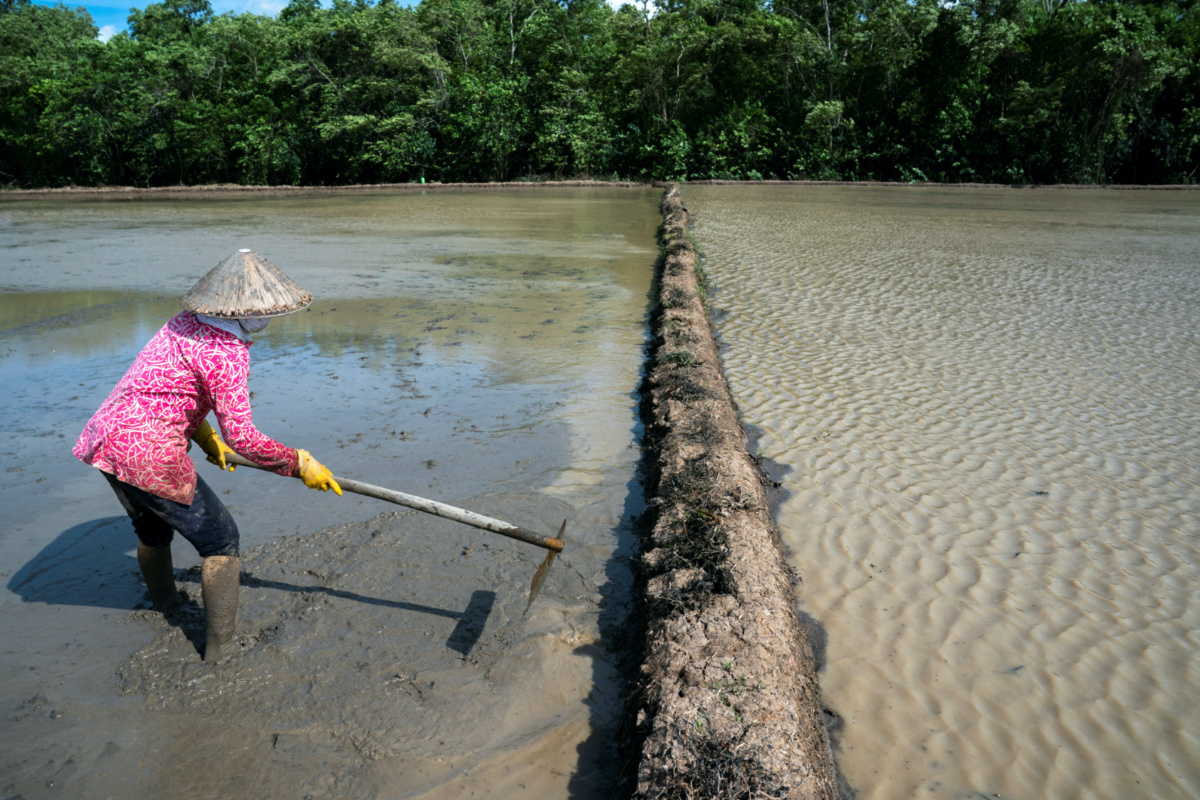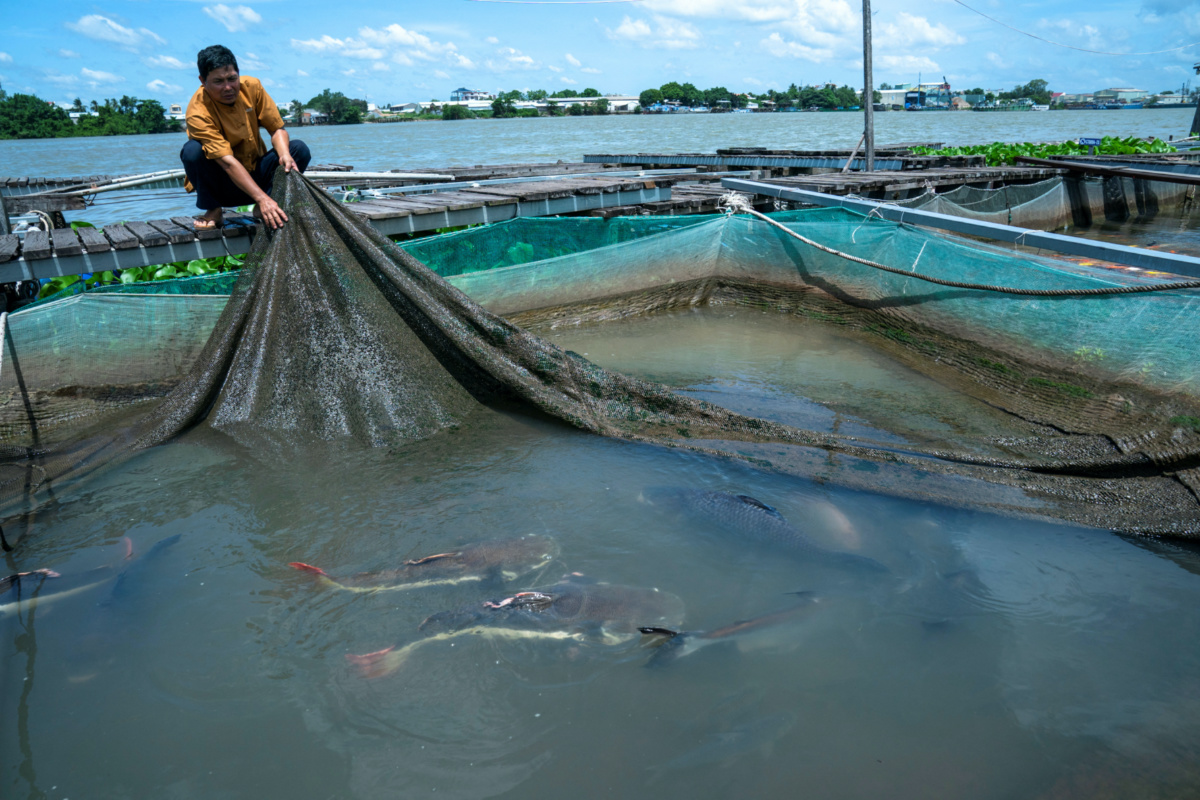
KANUPRIYA KAPOOR, SIMON SCARR AND PHUONG NGUYEN, of Reuters, report on the impact of Chinese-built hydroelectric dams on the Mekong River Delta…
Soc Trang, Vietnam
Reuters
Standing on the bank of the Mekong River, Tran Van Cung can see his rice farm wash away before his very eyes. The paddy’s edge is crumbling into the delta.
Just 15 years ago, South-East Asia’s longest river carried some 143 million tonnes of sediment – as heavy as about 430 Empire State Buildings – through to the Mekong River Delta every year, dumping nutrients along riverbanks essential to keeping tens of thousands of farms like Cung’s intact and productive.
But as Chinese-built hydroelectric dams have mushroomed upriver, much of that sediment is being blocked, an analysis of satellite data by Germany-based aquatic remote sensing company EOMAP and Reuters shows.

Ly Van Bon, owner of the Bay Bon fish pond located in the Mekong river which was affected by sediment, speaks with tourists in Mekong’s regional capital Can Tho, Vietnam, on 25th May. PICTURE: Reuters/Athit Perawongmetha
The analysis reinforces an estimate by the Mekong River Commission, set up in 1995 by countries bordering the river, that in 2020 only about a third of those river-borne soils would reach the Vietnamese floodplains. At the current rate of decline, the commission estimated, less than five million tonnes of sediment will reach the delta each year by 2040.
Stretching nearly 5,000 kilometres from the Plateau of Tibet to the South China Sea, the Mekong is a farming and fishing lifeline for tens of millions as it swirls through China, Laos, Myanmar, Thailand and Cambodia before reaching Vietnam.
“Without sediment, we are done.”
– Vietnamese farmer Tran Van Cung
“The river is not bringing sediment, the soil is salinised,” said Cung, 60, who has grown rice at his family’s 10 hectare farm for more than 40 years.
“Without sediment, we are done,” he said. His diminishing harvest now brings in barely half of the 250 million dong ($US10,636) annually that he earned just a few years ago, and his two children and several neighbours have left the area to seek more stable and lucrative work elsewhere.
For decades, scientists and environmentalists have warned upstream dam projects jeopardise livelihoods in a region of some 18 million people and an annual rice market of $US10.5 billion that is a major food source for up to 200 million people across Asia, according to WWF estimates, Reuters calculations and Vietnam’s Chamber of Commerce and Industry.
Worry shared by Lower Mekong nations has already led Cambodia to pause plans for two dams on the river, according to the Mekong Dam Monitor, an online platform that provides real-time data on dams and their environmental impact.
But in China and Laos, dam-building goes on. Of seven new dams planned in Laos, at least four are co-financed by Chinese companies, according to Mekong Dam Monitor data.

A farmer prepares a rice field in Mekong Delta’s Soc Trang province which was affected by the sediment, Vietnam, on 25th May. PICTURE: Reuters/Athit Perawongmetha
China’s foreign ministry said the country accounted for only a fifth of the total Mekong basin area and only 13.5 per cent of the water flowing out of the Mekong’s estuary, adding that there was already a “scientific consensus” on the impact of China’s upstream dams. The ministry did not address the slide in sediment levels or the role of Chinese dams in that decline.
Using data derived from thousands of satellite images, EOMAP and Reuters analysed sediment levels around four major dams on the Mekong, two in China and two in Laos. The analysis showed each dam drastically reduced the sediment that should have otherwise flowed through at those locations – by an average of 81 per cent of the sediment load across the four dams.
“The dams are trapping sediment…each one traps a certain amount, so there isn’t enough reaching the floodplains,” said Marc Goichot, a WWF river specialist in Vietnam who was not involved in the analysis but reviewed the results.
“Sediment and deltas should be able to regenerate and rebuild themselves,” he said. “But the pace at which the natural balance is being forced to change in the Mekong is too fast for the sediment to keep up.”
Farmers in the Vietnamese Mekong River Delta region were not prepared for the speed at which their landscape – and fortunes – have changed.
The area under rice farming has shrunk by five per cent in the last five years alone, with many forced to adopt shrimp farming in salty seawater as an alternative.
Incomes in this once-booming region are now among Vietnam’s lowest, even as the national economy grows at a projected eight per cent for 2022. The region has seen more outward migration than any other in Vietnam since 2009, according to Vietnam’s Chamber of Commerce and Industry.
The Mekong River Commission estimated in 2018 that total sediment flow by now would be around 47 million tonnes per year. It could be far lower – estimated at just 32 million tonnes per year, according to scientific studies from the last decade including one published in July 2021 in the journal Nature Communications.
“In the past three or four years there has been a wake-up call about sediment,” said the head of the commission, Anoulak Kittikhoun of Laos. “We definitely cannot return to sediment levels seen in the past. We need to preserve what we have.”

Ly Van Bon, the owner of the Bay Bon fish pond located in the Mekong river which was affected by sediment, shows redtail catfish inside his fish pond in Mekong’s regional capital Can Tho, Vietnam, on 25th May. PICTURE: Reuters/Athit Perawongmetha
Meanwhile China, eager to boost renewable energy capacity to reduce its reliance on coal, has already built at least 95 hydroelectric dams on tributaries flowing into the Mekong, called the Lancang in China.
Another 11 dams have gone up since 1995 on the main river itself in China – including five mega-dams each standing more than 100 metres tall – while China has helped to build two in Laos.
Dozens more are planned. State-owned Huaneng Lancang River Hydropower, tasked with developing resources, aims to double the network’s 21.3 gigawatt capacity by 2025, its chairman Yuan Xianghua told Reuters.
The analysis by EOMAP and Reuters of satellite images taken over three decades around four major dams in China and Laos found evidence that the dams reduce sediment flow drastically.
The analysis relied on measurements of turbidity depicted in the images – the amount of light scattered by solid particles suspended in water – as a proxy for sediment levels. Sediment clouds water as it flows: the muddier the water, the higher the turbidity and the more sediment it is likely carrying.
We rely on our readers to fund Sight's work - become a financial supporter today!
For more information, head to our Subscriber's page.
EOMAP used the same approach to gauge sediment in the Elbe River in 2010 and in hydropower reservoirs in Switzerland and Albania in 2021. Its findings on those waterways matched ground observations.
The satellite images for the Mekong analysis date back to the 1990s, which “allows us to calculate turbidity levels before many of the dams were built,” said EOMAP data analyst Philipp Bauer.
After discarding images obscured by cloud cover or pollution, the team was left with 1,500 depicting the turbidity around two dams in China and two in Laos. Experts not involved in the analysis agreed the findings made clear the dams were a key culprit behind the delta’s sediment loss.
“Mainstream dams catch everything,” said economist Brian Eyler at the Stimson Center, which runs the Mekong Dam Monitor. “China’s got 11 on the mainstream, plus other countries, so all these are working together to reduce sediment load.”
For example, before China built its fourth-largest dam at Nuozhadu in Yunnan province, the water’s turbidity measure in 2004 averaged 125.61 so-called ‘nephelometric turbidity units’, or NTUs, according to satellite data.
After the dam was completed in 2012, average turbidity at the same spot plummeted 98 per cent to just 2.38 NTUs – clear enough to meet the World Health Organization’s classification for drinking water.
The Xayaburi and Don Sahong dams in Laos are the most recent to come online, with Xayaburi the largest on the entire Mekong River. Average turbidity before China constructed the Xayaburi dam was 101.51 NTUs, while after the dam came online in 2019, turbidity tumbled 95 per cent to an average of 5.16 NTUs.
And on Laos’ southern border with Cambodia, turbidity fell about 42% to 42.39 NTUs after the Don Sahong dam started up in 2019.
Reuters asked both the Chinese and Laotian governments about the impact of their dams and plans to build more. China’s foreign ministry did not respond to questions about its existing and planned dams or their impact on sediment levels, while the Laotian government did not respond to requests for comment.
Governments of other countries through which the Mekong flows also did not respond to requests for comment.

Tourists enjoy their legs inside a carp fish pond at the Bay Bon fish pond located in the Mekong river which was affected by sediment in Mekong’s regional capital Can Tho, Vietnam, on 25th May. PICTURE: Reuters/Athit Perawongmetha
At Cung’s rice farm in Vietnam, riverbank seedlings have little time to take root before they fall into the water as the banks give way.
Located about 430 kilometres from the nearest upstream dam – and roughly 1,400 kilometres from the Chinese border – the farm area’s turbidity has dropped about 15 per cent in the last 20 years, to about 61 NTUs on average today, according to the analysis by EOMAP and Reuters.
Downriver countries affected by the dwindling sediment have lobbied unsuccessfully for China to share data on sediment flows as well as details of its dam-building plans. Beijing shares data only about the water levels and flow rates from its mainstream dams.
Last year, the Mekong River Commission launched its own joint study with China looking at the dams’ impacts, but the results won’t be known until 2024 at the earliest.
But while the commission has raised concerns about sediment depletion, “We have not had a serious conversation [with China] about sediment yet,” said commission chief Kittikhoun.
“Water flow is a priority. Working with China, you have to take it one step at a time.”
Sitting cross-legged by the river, rice farmer Cung said he and his peers have struggled to find information about how to adapt to the changes wrought by dams.
“It’s not an easy decision to make but sometimes quitting is the only economic choice that makes sense,” Cung said.
– Additional reporting by DAVID STANWAY, CLAIRE TRAINOR and MANAS SHARMA






